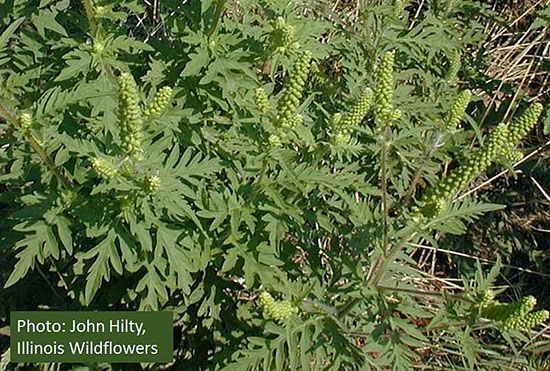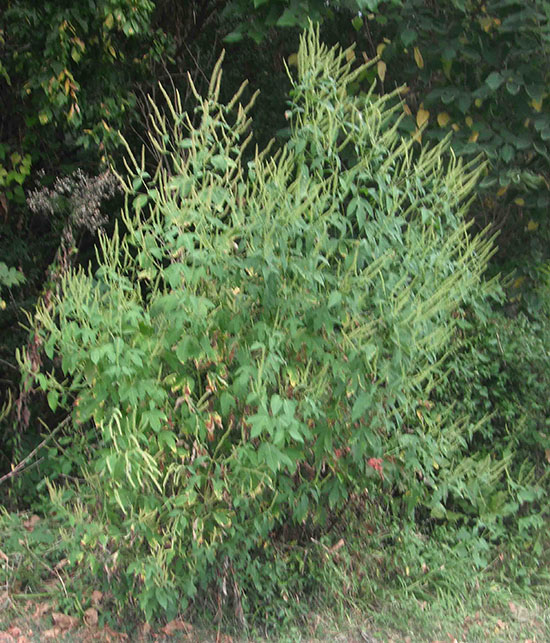Issue 16, September 20, 2016
Ragweed vs. Goldenrod
With ideal growing conditions, ragweed is in full bloom this autumn. That means those with allergies will be suffering tremendously.
There are two main forms of ragweed in Illinois: common and giant. Both carry the scientific genus of Ambrosia, which is somewhat odd concerning the historic Greek nature of the word. Most allergy sufferers would say the plant is far from the food of the Gods.
Common ragweed (Ambrosia artemisiifolia) has fern-like foliage, reaching about 2 to 3 feet in height. Stems are fuzzy and tinged pink. The plant is a summer annual, dying down with the first frost. The plant starts to bloom in July or August, with peaks in September. Flowers are green and non-showy. Seeds are brown with a high concentration of oils, making them attractive to birds. This allows for the plant's spread. Seeds may stay viable for 5 years. Bees and caterpillars are known to feed on this native plant.

Common ragweed (photo courtesy of John Hilty, Illinois Wildflowers).
Giant ragweed (Ambrosia trifida) reaches 6 to 7 feet in height, though under ideal conditions it may soar 10 to 12 feet high. Leaves can be singular or have up to five palmate lobes, generally opposite on the plant. Leaves can be larger than a human hand, and usually are serrated along the edges. Leaves right under the flower spike are often hairy. Stems are covered with fine white hairs. The plant, while an annual, appears woody toward the base. Flowers are also green. Seeds have a small bur; animals, people and machinery can move the seed from one location to another. Few, if any, animals feed on giant ragweed.

Giant ragweed.
Both ragweeds are wind pollinated. Their pollen is extremely small and easily blown by the wind. It's the pollen's size that irritates allergy-suffers.
Common and giant ragweed are on the Illinois Noxious Weed Act list, with one caveat. Plants must be controlled, which essentially means eradicated, but only within municipality boundaries including villages, towns, and cities. Rural control is not required.
Blooming at the same time is goldenrod (Solidago sp.) Like the ragweeds, it's a member of the Asteraceae family, but has bright yellow showy flowers. In a case of "guilt by association", goldenrod is often blamed for allergies. However, the plant is insect-pollinated since the pollen is quite heavy and sticky. Think the difference between a ping pong ball (ragweed) and a giant metal wrecking ball (goldenrod.) When blooming, the pollen drops to the ground or whatever is underneath the flowers, and is not blown in the wind. There are many cultivars of Solidago on the market for late-season flowering in the perennial garden.

Goldenrod.
Ideally, the best control of ragweed is mowing or hoeing them out when in the young stage in early summer before plants start blooming. Preemergence herbicides can be used in the spring if you have a history of the plant in a particular location. Herbicides this late in the season aren't practical. Grubbing out plants and burying or burning (where allowed) is the best option. (David Robson)
Author:
David Robson